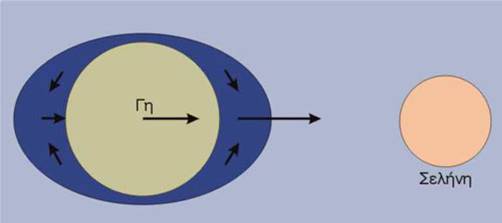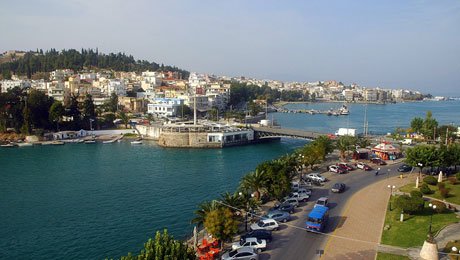Hellenic Republic
Municipality of Chalkida
The Home of Knowledge and Science in Chalkida
Tides and the Euripus phenomenon
Dr. Antonios Antoniou
PhD in Astrophysics
University of Athens
Everybody can observe that every 6 hours the sea water rises (flood) and in the next 6 hours it goes down again (ebb). We have a period of 12 h or 4 phases in 24h 50min 30sec. The 50 min and 30 sec difference from the “24 hours” refers to the Moon, because the Moon needs exactly this period of time to pass over the same place on Earth twice (Newton 1687).
Let’s assume that the Earth was still and consisted of sea water. Then, the Moon would create an enormous wave that would follow it to its rotation around the Earth (see Figure 1).
But reality is different. The Earth surface consists of continents and so this hypothetical high tide wave is blocked and moves otherwise. The coasts and the morphology of the sea’s bottom contribute to the development of the phenomenon in different ways.
The Sun contributes to the tide phenomenon. The tide force depends on the position of the three bodies (Sun, Earth and Moon). This force is stronger in the new moon phase and milder in the squaring phase (see Figure 2). The ratio of the earth’s tide force to the sun’s tide force is about 2.2. This means that the moon is mainly responsible – for the flood – ebb phenomenon. The sun contribution is at most 28%.
If we define as Height the highest flood minus the lowest ebb then at the Mediterranean coasts the height is about 25 cm, in extra cases 45 cm, at North Africa coasts it is about 1 m, in the Bay Fundy in Canada about 15.4 m and in the English Channel about 15m.

Figure1: The tide phenomenon in ideal case
Figure 2: The Sun contribution to the tide phenomenon
The Euripus phenomenon
The Euripus Channel has width 39m, length 40m,depth=8.5m, latitude φ=38° 27΄ Ν and longitude λ=24° 00΄ E (Figure 3).
A continuous motion of water is observed with a periodical change of its flow. The phenomenon is more intense in the conjunctions (Sun – Earth – Moon angle = 180 degrees) while in the squaring (Sun – Earth – Moon – 90 degrees) it is milder. The speed which has been measured is about 5-6 mil/h. and sometimes 9 mil/h.
Figure 3: The Euripus Channel
Characteristics of the phenomenon
a) Regular stream:
It is observed 22-23 days of the month. 11-12 days is during the new moon phase and 11 – 12 during the full moon phase. The flow goes from South to North for 6 hours and from North to South for the next 6 hours. There is a period of 12 h (like the flood – ebb phenomenon) or 4 changes in a period of time of about 24 h and 50 min.
b) Irregular stream:
It lasts about 6 days (3 during the first squaring and 3 during the last squaring).
Its characteristic is an irregular change of the stream (about 14 changes per 24 hours).
This irregular stream is a result of the mild indication of the phenomenon.
Explanation
The big tidal wave is created by the gravitation of the Moon in the East Mediterranean and is directed towards the west. When it reaches the South Aegean it heads north and arrives in the east coast of Evoia almost three hours after the moment the Moon passes the meridian of Halkida. However, the wave entering the SouthEvoikosBay reaches the Euripus channel 1 hour and 15 minutes earlier than the one entering the NorthEvoikosBay because the route is shorter. Moreover, the volume of the sea water of the south wave is bigger than the volume of the north wave because the north one is obstructed by the strait of north Evoia. So, when the south wave arrives in Euripus we notice a rise in the level of water in the south part of the channel, which goes up to 30-40 cm. This rise in the water level is the cause of the flow of water from the South to the North Evoikos bay. Six hours later conditions are reversed because in the meantime the wave entering the North Evoikos bay reaches the channel and the water level rises in the north part. As a result the stream is reversed. The period of 22 hours and 22 minutes has to be attributed to the shaping of the shore of the two sides of Evoikos bay (North and South) (see Figure 4).
Figure 4: The big tidal wave is created by the gravitation of the Moon in the East Mediterranean and is directed towards the west. The wave entering the SouthEvoikosBay reaches the Euripus channel 1 hour and 15 minutes earlier than the one entering the NorthEvoikosBay because the route is shorter. When the south wave arrives in Euripus we notice a rise in the level of water in the south part of the channel, which goes up to 30-40 cm. This rise in the water level is the cause of the flow of water from the South to the North Evoikos bay. Six hours later conditions are reversed because in the meantime the wave entering the North Evoikos bay reaches the channel and the water level rises in the north part. As a result the stream is reversed.
Who studied the phenomenon?
The first who found out the cause of the phenomenon was Aristotle (384 – 322 B.C.)
and Eratosthenes (275-195 B.C). The phrase «δεύρο κακείσε των πορθμών ταλαντεύεσθαι την θάλατταν πολλάκις» is attributed to Aristotle. Strabo attributes the phrase «ότι η εφ εκάτερα θάλαττα άλλην και άλλην επιφάνειαν έχει» to Eratosthenes. Both phrases indicate the tide as the cause of the phenomenon.
But the final solution was given by professor Dimitrios Aiginitis who relied on the material of the former researchers. It is the explication we mentioned before.
Why Euripus?
The word “Euripus” consists of the words ευ + ριπή (brash flow). The terminology Euripus is used internationally to signify streams with a strong rush.
Can we calculate the direction of the stream?
We can estimate the flow of the stream provided we are not found in the squaring phases when there is total disorder. The port authorities of Halkida issue an information leaflet which includes the direction of the streams for a lunar (synodical) month (Table 1).
Table 1: The direction of the streams for a lunar (synodical) month (Port Authority of Chalkida)
| N-S | S-N | S-N | S-N | |
| New Moon | 02.30-8.48 | 8.50-14.43 | 14.45-21.04 | 21.06-02.58 |
| 1 | 03.00-09.18 | 09.20-15.13 | 15.15-21.34 | 21.36-03.28 |
| 2 | 03.30-09.48 | 09.50-15.43 | 15.45-22.04 | 22.06-02.58 |
| 3 | 04.00-10.18 | 10.20-16.13 | 16.15-22.34 | 22.36-04.28 |
| 4 | 04.30-10.48 | 10.50-16.43 | 16.45-23.04 | 23.06-04.58 |
| 5 | 05.00-11.18 | 11.20-17.13 | 17.15-23.34 | 23.36-05.28 |
| 6 | 05.30-11.48 | 11.50-16.43 | 16.45-00.04 | 00.06-05.58 |
| 7 | Irregular stream | |||
| 10 | 00.01-06.18 | 06.20-12.13 | 12.15-18.34 | 18.36-00.28 |
| 11 | 00.30-06.48 | 06.50-12.43 | 12.45-19.04 | 19.06-00.58 |
| 12 | 01.00-07.18 | 07.20-13.13 | 13.15-19.34 | 19.36-01.28 |
| 13 | 01.30-07.48 | 07.50-13.43 | 13.45-20.04 | 20.06-01.58 |
| 14 | 02.00-08.18 | 08.20-14.13 | 14.15-20.34 | 20.36-02.28 |
| Full Moon | 02.30-08.48 | 08.50-14.43 | 14.45-21.04 | 21.06-02.58 |
| 16 | 03.00-09.18 | 09.20-15.13 | 15.15-21.34 | 21.36-03.28 |
| 17 | 03.30-09.48 | 09.50-15.43 | 15.45-22.04 | 22.06-03.58 |
| 18 | 04.00-10.18 | 10.20-16.13 | 16.15-22.34 | 22.36-04.28 |
| 19 | 04.30-10.48 | 10.50-16.43 | 16.45-23.04 | 23.06-04.58 |
| 20 | 05.00-11.18 | 11.20-17.13 | 17.15-23.34 | 23.36-05.28 |
| 21 | 05.30-11.48 | 11.50-17.43 | 17.45-00.04 | 00.06-05.58 |
| 22 | Irregular stream | |||
| 25 | 00.01-06.18 | 06.20-12.13 | 12.15-18.34 | 18.36-00.28 |
| 26 | 00.30-06.48 | 06.50-12.43 | 12.45-19.04 | 19.06-00.58 |
| 27 | 01.00-07.18 | 07.20-13.13 | 13.15-19.34 | 19.36-01.28 |
| 28 | 01.30-07.48 | 07.50-13.43 | 13.45-20.04 | 20.06-01.58 |
| 29 | 02.00-08.18 | 08.20-14.13 | 14.15-20.34 | 20.36-02.28 |
This post is also available in Greek Version.









It would be nice to know the simple schedule (day’s and time) for of the Euripus Phenomenon.
Or is it as big a mystery as trying to find it out
Please let me know what do you mean with the words “the simple schedule”. If you mean the direction of the stream for a lunar (synodical) month, it is above available.
I rejoin Don’s comment: very nice page, would be nice to have an interactive timetable that include the current date and moon state (“today”) and a forecast for the next seven days?
So the guest don’t need to first check the moon calendar…
Thanks again!!
*thumbs up*
Dear Dr. A. Antoniou,
thank you for a very helpfull post. In few days (the beginning of May) we will go through the chanell with a yacht flotilla [we are planning a race aroun Evia] and experience this in person. I have just studied the atricle by Eginitis and will try to explaine the processes to my team.
I am working on a book on ancient meteorology and these sorts of phaenomena are of special interest for me.
thank you again.
Yours